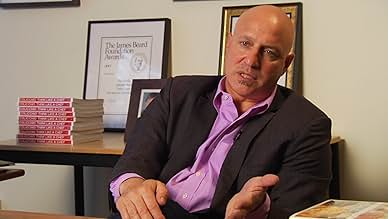IMDb रेटिंग
6.9/10
1.2 हज़ार
आपकी रेटिंग
अपनी भाषा में प्लॉट जोड़ेंA documentary that investigates incidents of hunger experienced by millions of Americans, and proposed solutions to the problem.A documentary that investigates incidents of hunger experienced by millions of Americans, and proposed solutions to the problem.A documentary that investigates incidents of hunger experienced by millions of Americans, and proposed solutions to the problem.
- पुरस्कार
- 1 जीत और कुल 2 नामांकन
Jim McGovern
- Self
- (as James McGovern)
फ़ीचर्ड समीक्षाएं
A PLACE AT THE TABLE (dir. Kristi Jacobson, Lori Silverbush) A brilliant documentary that confronts America's perennial inability to deal with the widespread problem of hunger in our nation. Ronald Reagan slashed federal programs that were beginning to solve the issue by the late 1970's, however he cynically felt that the matter would best be solved by relying on good old fashioned Christian charity. And it didn't work then, and it doesn't work now. Millions of Americans struggle daily with 'food insecurity' (you don't know where your next meal is coming from), and it seems that our leaders are convinced that the poor have it far too easy, and are just too dependent on the largess of the American tax payer. However, the film does expose the pertinent fact that America's richest food corporations were able to continue to enjoy 100% of their lavish federal government subsidy, yet the food stamp budget was severely cut to pay for a program to end childhood hunger. So much for our so called 'Christian' policies, and the film provides yet another reason for me to continue to be a proud secular humanist.
Lori Silverbush and Kristi Jacobson's documentary "A Place at the Table" is a film that every politician - indeed, every citizen - in America should be forced to sit through at least once (or as many times as it takes to get the message to effectively sink in). It makes a very persuasive case that, contrary to what most people think, hunger is a major problem in the United States, a nation that prides itself on being the wealthiest in the history of the world. Not only does the movie provide the startling statistics necessary to back that assertion up, but explains why this is the case.
Silverbush and Jacobson build their case in a meticulous, logical fashion, beginning with the common, counterintuitive fallacy that hungry people necessarily equal thin people. The movie explains how obesity and hunger often go hand in hand, thanks to the fact that, since junk food is cheaper than healthy food to purchase, the poor often fill up on empty calories rather than the nutritious ones that would actually make them healthy. This is a result of a misguided federal policy that provides subsidies for agribusinesses (as opposed to mom-and-pop farmers), who turn their grain and corn into inexpensive processed foods. Since farmers who grow fruits and vegetables work more independently of one another, they don't have the clout necessary to receive similar government support. This leads to a vicious cycle that winds up hurting poor people in both urban and rural areas where "food deserts" arise in which residents can barely find a fresh fruit or vegetable to purchase.
The movie rightly celebrates the many charities that pick up some of the slack, but it makes the case that that is simply not enough, that an entire paradigm shift may be necessary if we ever hope to solve the problem.
Ultimately, what we discover is that hunger is merely a symptom of a much greater set of problems - which are poverty, income inequality and a political system rigged to benefit the wealthy and powerful at the expense of the indigent and disconnected. Above all, the key lies in both the public and private sectors providing a living wage for their workers.
Finally, beyond all the statistics, beyond all the comments by experts and authorities on the subject, it is the voices of the parents, who can't afford to put nutritious food on the table for their children, and of the children themselves, who often go to bed hungry or malnourished, who wind up making the greatest mark on our hearts. It is their testimonials more than anything else that will hopefully move the rest of us to action.
A must-see film.
Silverbush and Jacobson build their case in a meticulous, logical fashion, beginning with the common, counterintuitive fallacy that hungry people necessarily equal thin people. The movie explains how obesity and hunger often go hand in hand, thanks to the fact that, since junk food is cheaper than healthy food to purchase, the poor often fill up on empty calories rather than the nutritious ones that would actually make them healthy. This is a result of a misguided federal policy that provides subsidies for agribusinesses (as opposed to mom-and-pop farmers), who turn their grain and corn into inexpensive processed foods. Since farmers who grow fruits and vegetables work more independently of one another, they don't have the clout necessary to receive similar government support. This leads to a vicious cycle that winds up hurting poor people in both urban and rural areas where "food deserts" arise in which residents can barely find a fresh fruit or vegetable to purchase.
The movie rightly celebrates the many charities that pick up some of the slack, but it makes the case that that is simply not enough, that an entire paradigm shift may be necessary if we ever hope to solve the problem.
Ultimately, what we discover is that hunger is merely a symptom of a much greater set of problems - which are poverty, income inequality and a political system rigged to benefit the wealthy and powerful at the expense of the indigent and disconnected. Above all, the key lies in both the public and private sectors providing a living wage for their workers.
Finally, beyond all the statistics, beyond all the comments by experts and authorities on the subject, it is the voices of the parents, who can't afford to put nutritious food on the table for their children, and of the children themselves, who often go to bed hungry or malnourished, who wind up making the greatest mark on our hearts. It is their testimonials more than anything else that will hopefully move the rest of us to action.
A must-see film.
"A Place at the Table" completely transformed my paradigm of America. When I hear the words "hunger" and "starvation," images of ravenous, malnourished, dying children in Africa instantly pop into my head. However, this poignant, simple, and impacting documentary showed me that "hunger" could be sitting right next to me in school. This 84-minute documentary details with moving austerity how and why even in America, the world's richest nation, children are going hungry.
Featuring Academy Award winner Jeff Bridges, the founder of the End Hunger Network, "A Place at the Table" follows people, all from different towns and cultural backgrounds, who are food insecure. In other words, they have no idea when and how their next meal is going to come in. 50 million people in America are food insecure. This not only stunts physical development but mental development as well. Take Rosie, a fifth-grader growing up in rural Colorado. She tries to focus in school, but hunger pains cause her to zone out or to imagine her friends and teachers as fruits. Her dream is that one day, her kids can do what they want to do and what they need to do without going hungry.
Another instance is Barbie, a single working mother with two kids. Her toddler son mumbles and has an attention-deficit symptom. This is because of the lack of food for Barbie and her family when he was born. The lasting effects of hunger in a child's first years impact a child much more deeply in the brain than the body. It's an emotional moment to see Barbie break down into tears in front of her kids, exhausted of the intense struggle to make ends meet.
The documentary grippingly touches on so many different issues. It clears up myths and breaks stereotypes. A false paradigm that America blindly looks through is that hunger doesn't exist because children struggle with obesity. However, obesity, hunger, and being food insecure go hand-in-hand. Because of a low income, families on a very limited budget shop for the cheapest foods in store – chips, cookies, and ice cream. Produce is simply too expensive.
Hunger exists not because there is not enough food. Hunger exists because it isn't a big enough issue on the political agenda. The documentary is packed with real statistics and visuals that are not just standard, cold numbers, but the toll of hunger is shown in the glimpses of families scrambling to break the cycle of poverty. This film calls out to audiences to end hunger in America by alerting politicians and the government. "It's just appalling," says actor Jeff Bridges. "You know if another country was doing this to our kids we would be at war. It's just insane and it doesn't have to be that way."
"A Place at the Table" will truly open your eyes to the harsh realities of a food insecure nation. I am determined to push forward in this fight of ending hunger, and I believe our nation can rise out of the pit we've buried ourselves in. America's youth has a passion and an unbendable will to fight for what's right, and if pointed in the right direction, I believe that the American Dream of prosperity can come true. The only thing standing between now and the extinction of hunger is the hurdle of ignorance, clouding youths' and the government's minds. Share this documentary with friends and family – I recommend this for all ages. If we act with urgency and boldness, perhaps one day, everyone will have a place at the table.
Reviewed by Cassandra Hsiao, KIDS FIRST! Film Critic, age 14. For more reviews, go to kidsfirst.org.
Featuring Academy Award winner Jeff Bridges, the founder of the End Hunger Network, "A Place at the Table" follows people, all from different towns and cultural backgrounds, who are food insecure. In other words, they have no idea when and how their next meal is going to come in. 50 million people in America are food insecure. This not only stunts physical development but mental development as well. Take Rosie, a fifth-grader growing up in rural Colorado. She tries to focus in school, but hunger pains cause her to zone out or to imagine her friends and teachers as fruits. Her dream is that one day, her kids can do what they want to do and what they need to do without going hungry.
Another instance is Barbie, a single working mother with two kids. Her toddler son mumbles and has an attention-deficit symptom. This is because of the lack of food for Barbie and her family when he was born. The lasting effects of hunger in a child's first years impact a child much more deeply in the brain than the body. It's an emotional moment to see Barbie break down into tears in front of her kids, exhausted of the intense struggle to make ends meet.
The documentary grippingly touches on so many different issues. It clears up myths and breaks stereotypes. A false paradigm that America blindly looks through is that hunger doesn't exist because children struggle with obesity. However, obesity, hunger, and being food insecure go hand-in-hand. Because of a low income, families on a very limited budget shop for the cheapest foods in store – chips, cookies, and ice cream. Produce is simply too expensive.
Hunger exists not because there is not enough food. Hunger exists because it isn't a big enough issue on the political agenda. The documentary is packed with real statistics and visuals that are not just standard, cold numbers, but the toll of hunger is shown in the glimpses of families scrambling to break the cycle of poverty. This film calls out to audiences to end hunger in America by alerting politicians and the government. "It's just appalling," says actor Jeff Bridges. "You know if another country was doing this to our kids we would be at war. It's just insane and it doesn't have to be that way."
"A Place at the Table" will truly open your eyes to the harsh realities of a food insecure nation. I am determined to push forward in this fight of ending hunger, and I believe our nation can rise out of the pit we've buried ourselves in. America's youth has a passion and an unbendable will to fight for what's right, and if pointed in the right direction, I believe that the American Dream of prosperity can come true. The only thing standing between now and the extinction of hunger is the hurdle of ignorance, clouding youths' and the government's minds. Share this documentary with friends and family – I recommend this for all ages. If we act with urgency and boldness, perhaps one day, everyone will have a place at the table.
Reviewed by Cassandra Hsiao, KIDS FIRST! Film Critic, age 14. For more reviews, go to kidsfirst.org.
My wife and I downloaded this from iTunes today and were so impacted by the film. The film follows several people of different races and backgrounds, urban to the South to the mountains of Colorado. All are working (as the film goes on) but none make enough to buy enough food to be sure it will last all month. Many of them do not even qualify for food stamps/bridge cards. The fact that the poor and hungry have little lobbying impact in Washington compared to the gigantic agribusiness flood of money is clearly part of the reason we see this dilemma where the richest large nation fails miserably in keeping its working poor feed. Please see this film if you care about this issue. Many of your opinions may turn out to be misconceptions founded on stereotypes.
As for Marc Newman's criticism, the idea that charity organizations like food kitchens and food banks sponsored by churches (yes, those clips of devoted pastors and churches were kept in and were very impressive) could solve this problem is ludicrous. We are talking about 50 million people and 13 million children. As my pastor (who is VERY conservative) says... the problem is overwhelming. There is no way volunteer and charitable organizations can meet the demand, and for Mr. Newman to suggest it could makes me wonder if he has ever worked at trying to get food to the poor. Many of us have done so and we know how huge this problem is... far beyond the resources of the faith community. As was noted in this documentary, the government once before almost totally eliminated hunger (in the late 70's) when both Democrats and Republicans (including Ronald Reagan) made it a priority. The government could do it again if it desired.
As for Marc Newman's criticism, the idea that charity organizations like food kitchens and food banks sponsored by churches (yes, those clips of devoted pastors and churches were kept in and were very impressive) could solve this problem is ludicrous. We are talking about 50 million people and 13 million children. As my pastor (who is VERY conservative) says... the problem is overwhelming. There is no way volunteer and charitable organizations can meet the demand, and for Mr. Newman to suggest it could makes me wonder if he has ever worked at trying to get food to the poor. Many of us have done so and we know how huge this problem is... far beyond the resources of the faith community. As was noted in this documentary, the government once before almost totally eliminated hunger (in the late 70's) when both Democrats and Republicans (including Ronald Reagan) made it a priority. The government could do it again if it desired.
A Place at the Table is a documentary that looks at hunger in America. The film follows several families and their struggles to fill their plates day after day. Band-aid fixes are just not cutting it. The problem of hunger in America is just getting worse. The film is a sobering look at the reality that many Americans face.
क्या आपको पता है
- ट्रिवियाThe original title for this documentary was "Hungry in America."
- कनेक्शनFeatured in Moyers & Company: United States of ALEC: A Follow-Up (2013)
टॉप पसंद
रेटिंग देने के लिए साइन-इन करें और वैयक्तिकृत सुझावों के लिए वॉचलिस्ट करें
विवरण
- रिलीज़ की तारीख़
- कंट्री ऑफ़ ओरिजिन
- आधिकारिक साइट
- भाषा
- इस रूप में भी जाना जाता है
- Mesto za stolom
- फ़िल्माने की जगहें
- Collbran, कालोराडो, संयुक्त राज्य अमेरिका(main location)
- उत्पादन कंपनियां
- IMDbPro पर और कंपनी क्रेडिट देखें
बॉक्स ऑफ़िस
- US और कनाडा में सकल
- $2,31,378
- US और कनाडा में पहले सप्ताह में कुल कमाई
- $92,257
- 3 मार्च 2013
- दुनिया भर में सकल
- $2,31,378
- चलने की अवधि1 घंटा 24 मिनट
- रंग
- पक्ष अनुपात
- 1.78 : 1
इस पेज में योगदान दें
किसी बदलाव का सुझाव दें या अनुपलब्ध कॉन्टेंट जोड़ें




































